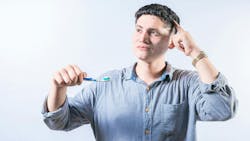Get a grip: How to help dental patients with proprioception dysfunction
Listen to the article on our podcast!
Proprioception is often called the sixth sense. It helps people understand where their body parts are in space without visual input. Proprioception dysfunction can occur due to an injury, neurological condition, or sensory processing disorder,1 and dementia is also a risk factor.
Proprioception matters to dental clinicians because it can significantly impact a person’s ability to maintain proper oral hygiene. These patients may have difficulty with fine motor skills, pressure discernment, and oral perception. This can make tasks such as brushing and flossing difficult and stressful.
How proprioceptive dysfunction affects oral care
Patients may have difficulty gauging the pressure they’re using while brushing. Some may apply too much pressure, resulting in gingival abrasions, recession, and possible abfractions. Others may use too little pressure and not effectively remove the plaque biofilm. Proprioception dysfunction may make it difficult for someone to sense where the toothbrush is in their mouth. This leads to inconsistent brushing and leaving areas unbrushed. They may not feel or notice food particles stuck in the interproximal spaces or notice that their teeth feel unclean.
Patients who have problems with fine motor skills may struggle with the precise hand movements needed to properly maneuver a toothbrush. Flossing can be an even bigger struggle due to the hand skills and coordination required. Another consequence of proprioception dysfunction is that some patients may experience increased sensitivity, which makes brushing or flossing painful or overstimulating. Others may be hyposensitive, which may necessitate stronger stimuli to recognize oral sensations.
Practical solutions for improving oral hygiene
There are many oral care aids and products that can help those with proprioception dysfunction with their oral care. When it comes to toothbrushes, using a weighted toothbrush may provide more sensory feedback and aid in patient control. Textured grips can also increase proprioceptive input and decrease the likelihood of the brush slipping from the hand.
Electric toothbrushes with pressure indicators can help identify when too much pressure is used and can help those with fine motor skills difficulty by reducing the effort needed to clean effectively. Sonic toothbrushes can provide more sensory input to aid in proprioceptive awareness.
Using floss holders for string floss requires less hand/finger coordination. Electric flossers are a good option as they have thick handles for an easier grip, and the electric motion aids in getting between teeth. The vibration can increase the stimuli and proprioception awareness. Water flossers can be advantageous as they require less coordination than string floss, and the water adds additional flushing action to remove debris and plaque biofilm the patient may not be aware is present.
Proprioceptive-oral exercises before brushing, such as chewing a chew tube, blowing bubbles, sucking through a straw, placing ice on the lip, or using a vibrating oral massager, can activate oral sensory pathways before brushing. These activities provide proprioception feedback that calms the nervous system.2 Using a mirror visual schedule (step-by-step guide) helps patients who struggle with spatial awareness.
Some may benefit from watching themselves brush to ensure they’re using the proper technique. Consistency is key, as is establishing a routine. Using a visual schedule can help reinforce good habits. Sensory-friendly apps or timers with vibration alerts encourage proper brushing duration.
How dental professionals can help
We can educate caregivers about the proper tools and techniques to support patients at home. Tailor the recommendations to each patient’s specific needs. Offer sensory-friendly dental visits that include storyboards indicating the steps of the visit, slow introductions to instruments, weighted blankets, and a calming environment.
By understanding the impact of proprioception on oral hygiene, dental professionals can support patients with proprioception dysfunction. Implementing practical adaptations, recommending the right tools, and providing structured guidance can make a world of difference in helping them achieve better oral health.
References
1. Han J, Waddington G, Adams R, Anson J, Liu Y. Assessing proprioception: a critical review of methods. J Sport Health Sci. 2016;5(1):80-90. doi:10.1016/j.jshs.2014.10.004
2. Sensory issues activity pack: Physiotherapy & occupational therapy. Royal Wolverhampton NHS Trust. 2021. https://www.rwt.nhs.uk/PIL/MI_8488114_01.09.21_V_2.pdf
About the Author

Lisa Curbow, BAAS, RDH, CDP
Lisa Curbow, BAAS, RDH, CDP, has been in clinical practice for almost three decades, serving in both periodontal and general offices. She has also served as an office manager and hospital coordinator. Lisa’s passion is in educating and empowering others to be better equipped to treat patients with special needs. She is a member of the SCDA, AADMD, and iADH. Lisa can be contacted at [email protected].


